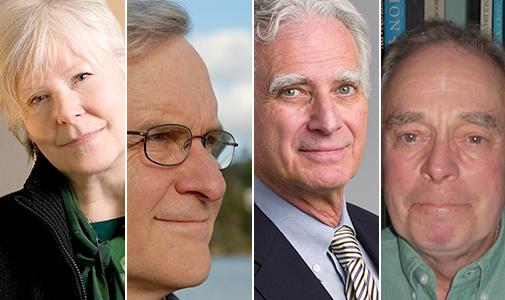Conference & Stage Expo
Collaboration: Myth or Reality?

Laura Crow, Michael Ramsaur, Leonard Auerbach, Randy Earle
Debuting at the Cincinnati 2015 Conference & Stage Expo is a totally new approach to programming by the Fellows. This year introduces The Conversation-- first in a series of in depth discussions among USITT Fellows and Friends. Each year the participants will change, but the topics will always be timely, the conversation informed, and the exploration lively,
The Fellows Conversation is part of the Thursday evening programming which will start with finger foods and a cash bar at 6:15, the conversation at 7 p.m., and be followed by a celebration of awards for those starting their careers.
An exploration of the much vaunted concept, collaboration, will kick off the Fellows Conversation series. Entertainment professionals are expected to collaborate. Many in the industry preach it, but do they in fact practice it?
Taking the stage in Cincinnati are three leading professionals and Fellows of the Institute: Laura Crow, Len Auerbach, and Michael Ramsaur. Randy Earle, Chair of the Fellows, will moderate. They will discuss many years of collaboration with clients, architects, fellow designers, directors, producers, and craftspeople. The emphasis is on how collaboration happens and dealing with “un-collaboration.”
“Collaboration? In this busy world?” asks Ms. Crow, University of Connecticut professor of costume design, “Designers are very willing to collaborate. It's often the directors who need training in collaboration. Our usual process is to create the world with lights and sets, and then we populate it. That leaves costume design as an afterthought. Surely we need to see the people first, and then we know what their world would look like.”
Looking at the topic from another perspective is S. Leonard Auerbach, chairman, Auerbach Pollock Friedlander - Theatre Consultants / Auerbach Glasow French - Architectural Lighting Design.
“Collaboration is not a myth, it is a tool for success. The practice of theatre consulting means different things to different people. I have found that there have been many changes over the years in the consulting practice and what I call ‘behavior of process.’ Just as in theatre, there is the creative team, the producers and the performers. Without effective leadership pulling together the team of creative collaborators, there would be no show. The leadership in the process shifts from the playwright to the director and the designers to the actors. The process requires collaboration as a tool for success. A merging of new ideas with solid experience is a healthy test of egos.”
“Collaboration is both a theatrical myth and the normal working condition,” adds Michael Ramsaur, Stanford University professor of lighting design. “Interesting that Mr. Webster’s definitions include both ‘to work jointly with others’ and to ‘cooperate with the enemy’ - both have an aspect related to our specific theatrical discipline. My years of experience have taught me that working in theater is collaboration. Effective collaboration is both listening and leading. A good collaborator is sensitive to the exchange of ideas and is able to determine when to push forward and lead, and when to listen and follow.”
Join the conversation. A question and answer opportunity will be provided. Join the Fellows at 7 p.m. Thursday, March 19 in Duke Grand Ballroom B.

